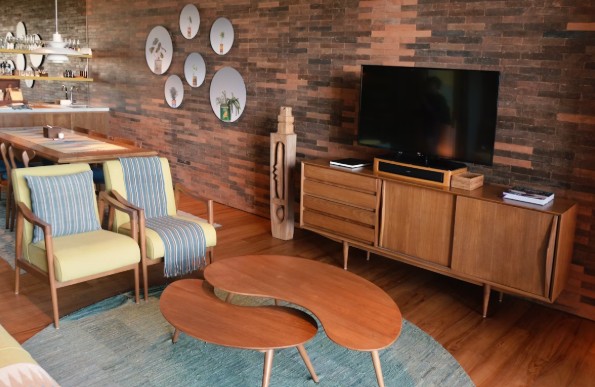Want to make your teak furniture last a lifetime?
Teak furniture is one of the best investments for outdoor furniture. It's long-lasting, gorgeous, and able to survive harsh elements year after year. But there's one small problem:
Without proper care, even the best teak furniture won't live up to its full potential.
Too many people make simple maintenance mistakes that drastically reduce their furniture's lifespan. The good news? They're all easy to avoid once you know what to look for. Plus, when it comes to teak furniture lifespan, proper maintenance makes all the difference between furniture that lasts 30+ years and furniture that has to be replaced every few years.
In this ultimate guide, I'll show you exactly how to avoid the most common teak furniture maintenance mistakes.
Here's what's inside:
10 Common Teak Maintenance Mistakes To Avoid
Why Your Cleaning Method Matters
The Truth About Oiling Teak Furniture
Natural Weathering vs. Actual Damage
The Pressure Washer Problem
This is by far the biggest mistake teak owners make.
People think "teak is tough, it can take a pressure washer." While teak is tough, high-pressure water is NOT something you want to blast it with.
High-pressure water is actually bad for the wood's surface.
The powerful jet erodes away teak's natural oils and sandblasts away the wood fibers. This damages the surface, leaving it rough and more prone to moisture damage.
Use a regular garden hose instead. Set it on low to medium and let it rinse away dirt without damaging the surface.
Over-Oiling Your Teak
Here's one that surprises most teak owners:
Did you know teak naturally produces its own oils? Those oils are what make teak so weather-resistant to begin with. Quality teak can last 30+ years outdoors because of these oils.
So why on earth would you need to add more oils?
Truth is, you probably don't. Oiling your teak furniture too much creates a host of problems:
Sticky residue that attracts dirt and grime
Mold and mildew growth
Draws out wood's natural protective oils
If you want to oil your furniture, do it sparingly (once or twice a year at most). Better yet? Just let the wood's natural oils work their magic.
Wrong Cleaning Tools
Let me show you another common mistake…
Many people grab steel wool, brass brushes, or metal scrubbing pads to clean their teak furniture. Not good. Those tools are way too abrasive for teak.
Metal brushes scratch the surface and damage the wood's finish. The scratches create tiny grooves that trap moisture and encourage rot.
Here's what to use instead:
Soft-bristle brushes
Soft plastic brushes
Simple kitchen Scotch Brite pad
Scrub always along the grain, not against it. Don't over-scrub either – use just enough to dislodge dirt and debris.
Natural Weathering vs. Actual Damage
Here's something kind of interesting:
Teak naturally weathers from honey-brown to a silver-gray patina. This happens in about 5-12 months depending on the climate and sun exposure.
And the really cool part? This color change is 100% normal.
The gray patina only affects the top layer of the wood. It doesn't change the wood's strength, durability, or expected lifespan at all. A lot of people even like this weathered gray look better. They say it gives furniture a more sophisticated appearance.
But if you want the furniture to stay golden… then you have to clean and seal it regularly. Just understand that you'll be fighting natural weathering if you do.
The Harsh Chemical Trap
This one can seriously damage your teak furniture.
If you use harsh chemical cleaners (especially ones with high ammonia or chlorine bleach), you'll strip away protective oils and discolor the wood.
The wood becomes dry, brittle, and more likely to crack over time. Some chemicals can even react with teak's natural compounds and create permanent stains.
Stick to mild, natural soap mixed with water for regular cleaning. Use a specialized teak cleaner for tougher stains.
Proper Storage Mistakes
Here's one people make and don't even realize it:
If you leave teak furniture sitting in standing water or store it in damp conditions, it'll deteriorate faster. Teak is water-resistant, but excess moisture over long periods is still bad.
Keep an eye out for these storage mistakes:
Furniture legs sitting in puddles of water or wet grass
Furniture stored in a non-ventilated space
Covering teak furniture while it's still wet
Make sure furniture legs drain and air circulates well. If storing in winter months, keep furniture in a dry, well-ventilated space. Use a breathable cover that lets moisture escape.
Neglecting Regular Cleaning
Think teak is maintenance-free furniture?
Nope, not really. Teak needs less maintenance than other wood types, but it still needs some love. Over time, dirt, pollen, and other debris accumulate on teak's surface.
If you don't clean it off, that buildup will trap moisture against the wood. It also creates a welcoming environment for mildew to grow (especially in humid climates).
Clean teak furniture at least twice a year.
Regularly hose it down and scrub it with mild soapy water. You'll keep the buildup off and airflow good around the wood's surface.
Low-Grade Teak Quality
This mistake happens before you even get the furniture home.
Not all teak is created equal. Teak wood comes in different grades depending on which part of the tree it's cut from.
Grade A teak comes from the tree's heartwood (dense center of mature trees). It has the most oils, best weather resistance, and longest lifespan. This is the stuff you want for outdoor furniture.
Cheaper, lower grades are cut from outer sapwood areas of the tree. Sapwood has fewer natural oils and doesn't weather as well outdoors.
Buying and investing in Grade A teak from the start means:
Longer furniture lifespan
Better weather and rot resistance
Less maintenance over the long haul
Cheaper teak furniture often uses lower grade teak. You'll save money now but have to replace it sooner.
Painting/Varnish Teak Furniture
Here's a BIG one that really damages teak:
Painting or varnishing teak furniture. Teak's natural oils repel varnish and paint, so those finishes won't stick properly to the wood.
If you varnish or paint teak, the finish will quickly chip and peel all over the place. Instead of looking great, the furniture just looks ugly. The peeling creates spots where moisture can get trapped and cause rot.
Teak doesn't need varnish or paint. It's natural properties already provide top-notch protection from outdoor elements. If you want to keep the golden color, just use a teak-specific sealer instead.
Bottom Line
Avoiding these 10 common teak furniture maintenance mistakes can dramatically improve the longevity of your investment. With proper care, quality teak furniture can last for generations and become a family heirloom.
Key is to remember that the wood's natural properties do most of the heavy lifting for you. Your job isn't to constantly over-maintain it. Your job is to just not make the mistakes that interfere with its natural durability.
To quickly recap, here are the 10 most common mistakes to avoid:
Don't use a pressure washer and harsh chemicals
Don't over-oil and use metal brushes
Allow natural weathering or keep up with cleaning/sealing consistently
Store with proper drainage
Clean regularly (but gently)
Get Grade A teak furniture from the start
Don't paint or varnish your teak furniture
Follow these teak furniture longevity tips and your investment will pay off for decades to come. Remember, the best maintenance routine for teak is the one that respects its natural properties.










